HRRA:
High-Resolution Anitaliasing Through Multisampling
NVIDIA’s
GeForce3 graphics processing unit (GPU) introduces radical new technology
designed to provide the industry’s first solution for high-resolution
antialiasing (HRAA). While other antialiasing solutions and their methods
have been offered before, only GeForce3 can offer the unique combination
of high resolutions and high frame rates in combination with high-quality
antialiasing. By implementing hardware support for multisampling, as
well as innovating new sampling technology, GeForce3 makes HRAA available
for all real-time content.
Generic
Solutions for Antialiasing
One of
the key image quality problems that has plagued PC users is aliasing,
or the “jaggies”. Aliasing is the stair-step effect on the
edges of objects and can be extremely distracting for the PC user. Readers
who are unfamiliar with aliasing and its causes are referred to Appendix
A for a more detailed explanation.
Higher
Resolution - The only way to combat aliasing is to create the effect
of having more pixels on the screen. Historically, increasing the resolution
was the best solution to this problem. The size of the “jaggy”
or stair-step artifact is never larger than the size of the actual pixel.
Hence, reducing the size of the pixel reduces the size of these artifacts.
Changing the resolution is not always feasible, however. The user may
already be using the maximum resolution supported by the monitor, or
the application itself may limit the resolution. Beyond these hard limits
the only solution is to increase the effective resolution. The best
way to do this is to use more sophisticated techniques for computing
the color of each pixel of the display in a way that simulates having
more pixels. These techniques are referred to as "antialiasing."
Supersampling
- Algorithmic antialiasing techniques involve "sampling" the
content of each pixel at multiple locations, meaning that the color
is computed at more than one location inside the area covered by the
pixel. The results from these "samples" are combined to determine
the final color of the pixel. These samples are essentially additional
pixels, used to increase the effective resolution of the image to be
displayed. If the edge of an object falls partially inside the area
of a pixel, its color and the color of another object that partially
fills the "area" of the pixel can both be used to calculate
the final color. The result is smoother transitions from one line of
pixels to another line of pixels along the edges of objects, where aliasing
is most obvious.
"Supersampling"
is an antialiasing technique that is simply a brute force approach and
is used in NVIDIA's GeForce2 GPUs and other modern graphics processors.
A graphics processor that uses supersampling renders the screen image
at a much higher resolution than the current display mode, and then
scales and filters the image to the final resolution before it is sent
to the display. A variety of methods exist for performing this operation,
but each requires the graphics processor to render as many additional
pixels as required by the supersampling method. Additionally, because
the graphics processor is rendering more actual pixels than will be
displayed, it must scale and filter those pixels down to the resolution
for final display. This scaling and filtering can further reduce performance.
The degree
of scaling in a specific supersampling mode is often identified by the
ratio of pixels in the unscaled image to the number of pixels in the
final, scaled output. For example, 2x supersampling writes twice as
many pixels to the frame buffer as would be required without antialiasing.
4x writes four times as many pixels. As you might guess, supersampling
causes a substantial drop in performance as measuredby frame rate. If
the graphics processor renders four times as many pixels, then the frame
rate will be one fourth what it was in the standard display mode. In
fact, the performance drop can be even worse than the "x"
multiple of the supersampling setting because of the scaling step mentioned
in the previous paragraph.
The biggest
problem with supersampling is performance. Users don't want to see their
frame rate fall to one-half or one-fourth of what it should be. Multisampling
is a more sophisticated technique than supersampling that involves higher
quality output than standard rendering with much higher performance
than supersampling--a win/win scenerio compared to either alternative.
Multisampling requires a more sophisticated GPU, however, so only the
newest GPUs available support this technique.
Multisampling
for High-Resolution Antialiasing (HRAA)
The basic
idea behind multisampling is to embed the intelligence behind antialiasing
inside the core of the GPU, in hardware. This makes the GPU more complex,
but rewards the user with higher quality and higher performance.
Multisampling
works because the GPU itself is "aware" that multiple samples
will be used to calculate the final pixel color. You can think of these
extra samples as extra "virtual pixels." The GeForce3 GPU
has wider data paths internally so it can handle these extra virtual
pixels without slowing down its standard rendering speed. In fact, the
GeForce3 GPU can compute these “virtual pixels” or additional
samples at full speed, with no reduction in engine performance whatsoever.
These wider data paths enable GeForce3 to use the same texture data
for all of the samples in the pixel and significantly reduce the memory
bandwidth required to texture all of the AA samples. Memory bandwidth
can be the performance bottleneck for high-resolution display modes
and becomes even more constraining when antialiasing is used.
GeForce3
has new technology for graphics hardware antialiasing in the form of
multisampling using a new sampling pattern. The locations of the sample
points for multisampling enable the use of a "reconstruction filter"
that uses data from neighboring pixels to compute the final pixel color.
This increases the total amount of work, and therefore slows down the
frame rate marginally, but it delivers much higher quality as a reward.
This new sampling pattern is called Quincunx, after the name of the
pattern of the five dots on the “5” sided of a 6-sided die.
This Quincunx pattern, implemented in hardware, offers quality comparable
to “4x” modes, with performance similar to that of “2x”
modes. The higher quality yielded by using a Quincunx reconstruction
filter is a key advancement and offers a fundamental improvement in
the quality vs. performance tradeoff of antialiasing.
The Quincunx
antialiasing (AA) mode works so well because it uses data samples from
neighboring pixels instead of requiring the GPU to create additional
samples for each pixel in the initial rendering step. Figure 1 shows
the sample grid and how samples from neighboring pixels are used.
Because
the Quincunx AA mode uses samples from neighboring pixels, it balances
the image quality benefit of using more input data to reconstruct the
final pixel versus the performance degradation of writing more samples
per pixel out to the frame buffer. In addition, because the Quincunx
method is twice as efficient as traditional 4x, Quincunx AA only requires
the smaller memory footprint that 2x modes require, allowing for higher
native resolutions without bumping into the limits of graphics card
memory.
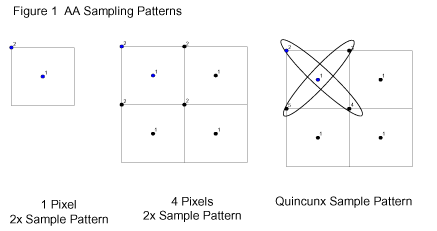
Figure
2 shows the memory footprint of key antialiasing display modes.
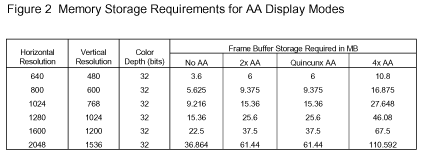
Figure
3 provides a comparison of the data sample points used to reconstruct
each pixel for the Quincunx AA mode compared to a standard 4x mode.
The locations of these sample points apply specifically to NVIDIA's
GeForce3. Other GPUs may take pixel samples at different locations within
the pixel area.
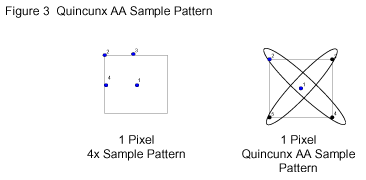
Results
The true
test of any antialiasing solution is the balance of performance and
image quality. NVIDIA’s Quincunx AA is the ultimate balance of
these two qualities. Figure 4 shows magnified samples from actual Quake
IIITM screen shots to highlight the visual differences between GeForce3’s
antialiasing modes. Note the similar complexity of the Quincunx AA and
the 4x examples. The larger number of intermediate colors is driven
by the larger number of samples that both Quincunx AA and 4x use to
reconstruct the pixel, compared to the standard 2x mode.
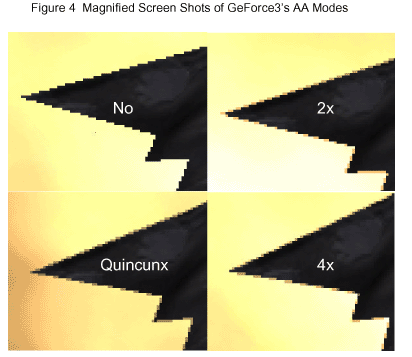
Figure
5 shows a larger section of the screenshots for three of the four settings
in figure 4: Off, Quincunx AA, and 4x.
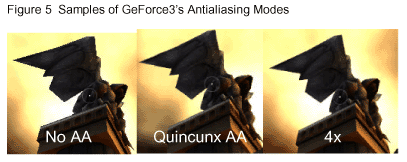
GeForce3
delivers these antialiasing modes with incredible performance levels.
This is the first GPU that delivers frame rates above 60fps in high-resolution
modes. For this reason, GeForce3 is the first GPU to deliver HRAA, or
high-resolution antialiasing, to the end user. Lesser GPUs can technically
support antialiasing, but users simply turn it off because the frame
rates are too low for serious game playing. HRAA requires a minimum
of 60fps at 1024x768 with full 32-bit color. Figure 6 shows the relative
performance levels for several AA modes.
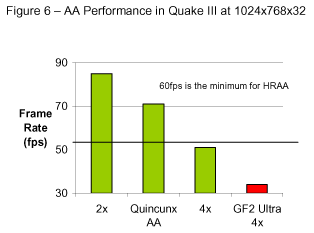
Conclusion
The GeForce3
GPU is the first product ever to deliver HRAA at a consumer price point.
The hardware multisampling capabilities of the GeForce3 GPU offer an
unprecedented level of performance and flexibility, giving end users
more and better mode choices for antialiasing, and helping them tap
the full potential of this groundbreaking graphics processor.
Appendix
A - Causes and Effects of Aliasing
Aliasing
is the stair-step effect that is highly visible on computer displays
when a line is drawn at an angle close to vertical or close to horizontal,
but not exactly vertical or horizontal. This stair-step effect is often
referred to as the "jaggies" because it makes lines that should
be smooth appear jagged. The height (or width) of each stair step is
equal to a pixel on the computer display. Figure 1A shows a screen shot
that shows several image defects cause by aliasing.
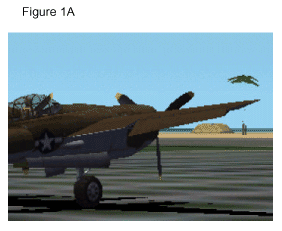
Aliasing
can also make a line appear thicker than it should be. Both of these
image "defects" are shown in Figure 2 which includes two versions
of a line: one near perfect line and the other heavily aliased.
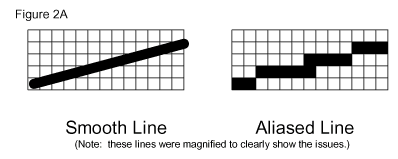
What causes
aliasing? In the simplest terms, aliasing is caused by the "grid"
of pixels in a computer display. Virtually every computer display is
what is called a "raster" display, meaning that pixels are
located in exact rows and columns. Aliasing occurs when a line crosses
those rows and columns at a slight angle to either the row or the column.
The result is that a specific point on a line that should be 1-pixel
wide might be half on one row and half on a neighboring row. Using the
near-horizontal line from Figure 2 as the example, this leaves 3 choices
for which pixels get filled in whenever the line is crossing from one
row on the display to another: only the pixel on the bottom row, only
the pixel on the top row, or both pixels. Each choice involves trade-offs.
If both pixels are filled in, the line becomes 2 pixels wide, if only
one pixel is filled in for any column of pixels, then the line narrows
to almost nothing where the line transitions from one row of pixels
to a neighboring row. Both of these "defects" are shown in
Figure 2.